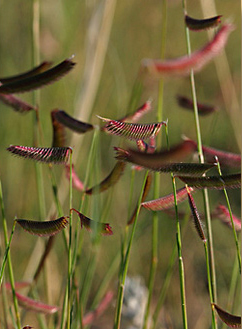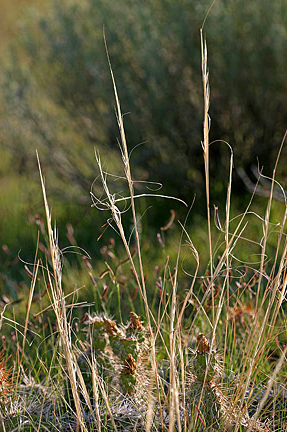The distinctive flowers of blue grama grass resemble bushy eyebrows. Grama is a Spanish word for grass.
Mixed Prairie Ecosystem
As Lewis approached the Sun River at about 65 miles above its mouth, he studied the valley in more detail. “The land of neither the plains nor bottoms is fertile,” he observed. “It is of a light colour intermixed with a considerable proportion of gravel.” The grass, he added, averaged only nine inches in height.
Much rejoiced at finding ourselfes in the plains of the Missouri which abound with game,” Lewis crowed. “R. Fields killed a fine buck and a goat [pronghorn]; Josh. Fields saw two buffaloe below us some distance which are the first that have been seen. we saw a great number of deer goats and wolves as we passed throuth the plains this morning but no Elk or buffaloe . . . I killed a very large and the whitest woolf I have seen.”
Lewis was back in the mixed prairie ecosystem, where only short-stemmed, deep-rooted grasses can survive. Some authorities refer to it as the short grass prairie, which extends from the Rocky Mountain Front to central North Dakota. [1]Robert G. Bailey, “Description of the Ecoregions of the United States.” USDA Forest Service Misc. Pub. 1391 (1995). Here, at its western margin, the annual precipitation averages between 10 and 14 inches, most of it falling between May and July, with successive years of severe drought occurring periodically. It is so dry, in fact, that trees will not grow except on the margins of rivers and major streams. Three of the most abundant of species in the mixed grass prairie were blue grama, bluebunch wheatgrass, and needlegrass.
Blue Grama
Blue grama (Bouteloua gracilis) consists of leaves up to six inches long, and stems up to 20 inches. The genus, pronounced Boo-til-loo-ah, was named for Claudio Boutelou (1774-1842), a professor of agriculture in Madrid, Spain. The specific epithet, gracilis, pronounced gra-sill-iss, means “slender,” in reference to its leaves.
Needle-and-thread Grass
Needle-and-thread grass (Stipa comata) or speargrass, is the tallest of the three, its culms (stalks) reaching from one to three feet above ground, though its leaves are only four to 12 inches high. Its roots may extend more than 50 inches into the earth. The genus name, Stipa (sty-pa) comes from a Greek word meaning “tow” or “fiber,” from the feathery appearance of the tips of the stalks. The name of this species, comata, is Latin for “long hair.” The whispy, corkscrew-shaped parts are called awns. Each has a needle-pointed seed at one end. When the awns fall away they land seed-first on the ground. Wind spins the awn, driving the seed into the ground. [2]John E. Taylor and John R. Lacey, Range Plants of Montana (Bozeman: Montana State University Extension Service, 1994). Michael Champion,”Stipa comata Trin. & Rupr., … Continue reading
Credits: Alan H. Hartley, linguistics, Detroit, Michigan; Robert N. Bergantino, geologist, Western Montana School of Mines and Geology; Marilyn Hudson, Curator, Three Tribes Museum, Newtown, North Dakota; Jack Lepley, manager, Museum of the Northern Great Plains, Fort Benton, Montana; David Alt, Professor Emeritus, Geology Department, The University of Montana, Missoula.
Notes
| ↑1 | Robert G. Bailey, “Description of the Ecoregions of the United States.” USDA Forest Service Misc. Pub. 1391 (1995). |
|---|---|
| ↑2 | John E. Taylor and John R. Lacey, Range Plants of Montana (Bozeman: Montana State University Extension Service, 1994). Michael Champion,”Stipa comata Trin. & Rupr., “http://www.usask.ca/agriculture/plantsci/classes/range/stipacomata.html, accessed April 6, 2005. |


